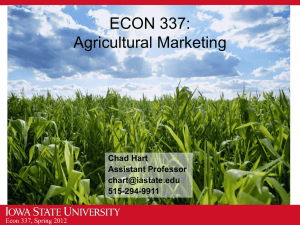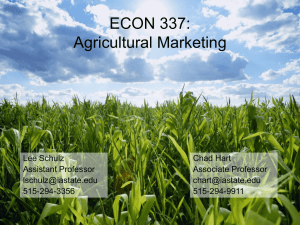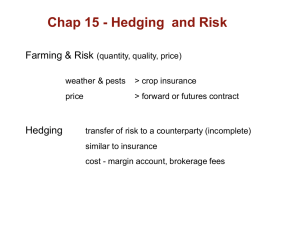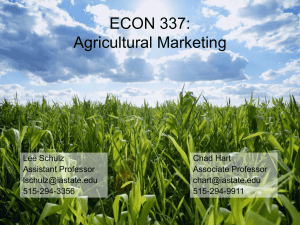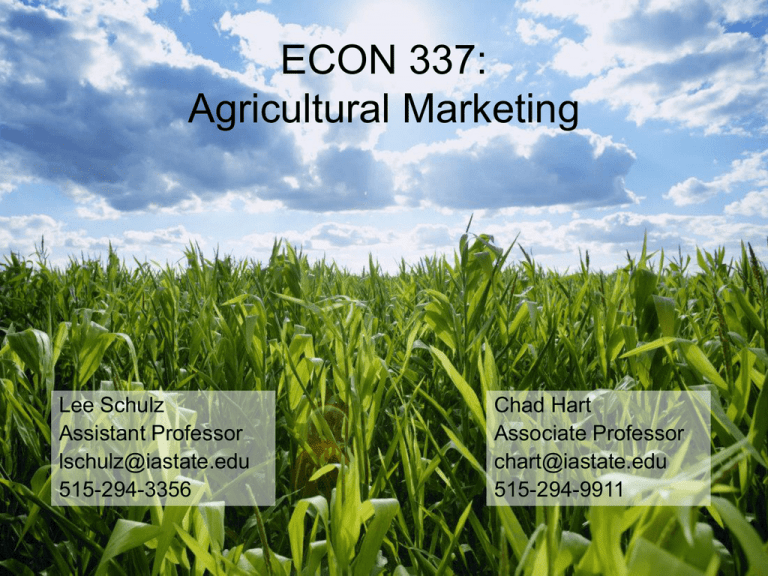
ECON 337:
Agricultural Marketing
Lee Schulz
Assistant Professor
lschulz@iastate.edu
515-294-3356
Chad Hart
Associate Professor
chart@iastate.edu
515-294-9911
Basis
Basis = Cash – Futures
Futures reflect global supply and demand
Basis reflects local supply and demand
Cash = Futures + Basis
Basis Basics
Specific to time and place
Typically use nearby futures
Convergence
Less variable than cash prices
Relatively predictable
Basis Factors
Relative storage capacity
Transportation availability and cost
Time to expiration
Quality issues
Basis Terms
Interior Iowa Daily Grain Prices
http://www.ams.usda.gov/mnreports/nw_gr110.txt
Closing cash grain bids offered to producers as of 3:00 p.m.
Dollars per bushel, delivered to Interior Iowa Country Elevators.
US 2 Yellow Corn Prices were generally steady to 1 cent higher for a state average of 4.23.
US 1 Yellow Soybean Prices were generally 8 to 10 cents higher for a state average of 12.43.
Iowa Regions
#2 Yellow Corn
#1 Yellow Soybeans
Range
Avg
Range
Avg
Northwest
4.05 – 4.26 4.20 12.35 – 12.47
12.42
North Central 4.19 – 4.41 4.27 12.35 – 12.53
12.42
Northeast
4.18 – 4.31 4.24 12.24 – 12.53
12.36
Southwest
3.94 – 4.29 4.13 12.38 – 12.60
12.50
South Central 4.19 – 4.34 4.24 12.39 – 12.58
12.44
Southeast
4.15 – 4.38 4.26 12.36 – 12.51
12.44
Corn basis to STATE AVERAGE PRICE for the CBOT MAR contract is -.11
Soybean basis to STATE AVERAGE PRICE for the CBOT MAR contract is -.40
Specific to Time and Place
Average Iowa Corn Basis, 2007-11
Source:
http://www.extension.iastate.edu/agdm/crops/pdf/a2-41.pdf
Iowa Corn Basis, May Futures, 2007-11
Source:
http://www.extension.iastate.edu/agdm/crops/pdf/a2-41.pdf
Iowa Corn Basis, May Futures, 2007-11
Source:
http://www.extension.iastate.edu/agdm/crops/pdf/a2-41.pdf
Basis Information
ISU Extension and Outreach, Ag Decision Maker
Corn http://www.extension.iastate.edu/agdm/crops/html/a2-41.html
Soy http://www.extension.iastate.edu/agdm/crops/html/a2-42.html
Cattle http://www.extension.iastate.edu/agdm/livestock/html/b2-42.html
Hogs http://www.extension.iastate.edu/agdm/livestock/html/b2-41.html
USDA-Ag. Marketing Service
http://www.ams.usda.gov/mnreports/lsddgr.pdf
http://www.ams.usda.gov/mnreports/nw_gr110.txt
Local elevators, ethanol plants, processing plants, etc.
Basis and price forecasting tool
Enter specific information
Location
Date
Weight
Frame score and grade
Sex
Number
Sex
Frame
Grade
Head
= Steer
= Lg & Med/Lg
=1
= 100
Sex
Frame
Grade
Head
= Steer
= Lg & Med/Lg
=1
= 100
Seasonal Price Patterns & Basis
Period of increasing supplies, prices are expected to decline.
Cash market reflects today's supply conditions and price.
Futures market reflects upcoming conditions of expected larger
supplies and lower prices.
Basis may be very narrow or cash price may be above futures.
i.e., Hogs: mid-August to mid-September.
Period of decreasing supplies, prices are expected to increase.
i.e., Hogs: late-Dec and early-Jan against the Feb futures.
Seasonal price period of relatively large supplies and low cash
prices, but the Feb futures contract reflects a delivery period of
expected smaller supplies and higher prices.
Low cash prices and high futures translate into a wide basis.
Threat of Delivery & Basis
Hedgers can deliver on a futures contract.
If enough producers deliver on futures contracts,
cash prices will tend to move up relative to futures.
The threat of delivery tends to limit how wide the
basis will be during the delivery period.
The variation in basis during delivery periods tends
to be less than during periods with no delivery
option.
Grain Basis vs. Livestock Basis
Grain is a storable commodity and the same
grain can be used to satisfy several futures
contract delivery months. So grain futures
prices tend to be tied to one another.
Livestock is not storable so livestock futures
prices for alternative delivery months tend to
move independently.
Because grain is a storable commodity, the
grain basis is tied closely to grain storage costs
and interest costs. Livestock are not storable so
there are no storage costs built into the basis.
Grain Basis vs. Livestock Basis
An inverse basis in grain futures (cash above
futures) is unusual and indicates there is
something amiss in the grain industry (lack of
transportation, for example). An inverse basis in
grains will usually last only for a short period.
An inverse basis in livestock futures is not
unusual for distant delivery contracts and can
exist for extended periods of time. Only during
the nearby futures contract delivery periods do
we expect livestock futures to be above cash
price.
Convergence
13.50
13.30
13.10
12.70
12.50
12.30
12.10
11.90
11.70
Futures
Cash
11/1
10/1
9/1
8/1
7/1
6/1
5/1
4/1
3/1
2/1
11.50
1/1
$ per bushel
12.90
Convergence Issues
Typically, as futures contracts reach maturity, futures
price and cash prices at delivery points tend to
converge to the same level.
For several grain and oilseed futures contracts over
the last few years, this has not occurred.
“Poor Convergence Performance of CBOT Corn,
Soybean and Wheat Futures Contracts: Causes
and Solutions”
Scott Irwin, Philip Garcia, Darrel Good, and Eugene Kunda
University of Illinois, March 2009
Why Is Convergence An Issue?
1. Non-convergence indicates the market is out-ofbalance.
“When a contract is out of balance the disadvantaged side
ceases trading and the contract disappears.”
(Hieronymus, 1977)
2. Non-convergence adds to the uncertainty in basis
and limits hedging effectiveness.
Source: Irwin, Garcia, Good, and Kunda, 2009
Marketing and Outlook Research Report 2009-02
Factors
The relationship between the spread between
futures contracts and the cost of carry (think
storage costs)
In the settlement process for corn and soybean futures,
the delivery instrument is a shipping certificate.
If it is advantageous to the holder of a shipping
certificate, they can delay delivery and effectively store
the grain, paying CBOT set storage costs.
Structural issues related to the delivery process
Does the general trade flow of the commodity line up
with the possible delivery points under the futures
contract?
Source: Irwin, Garcia, Good, and Kunda, 2009
Marketing and Outlook Research Report 2009-02
Delivery Points
How much of the commodity is
moving through the delivery point
areas?
Corn
Soybeans
Wheat
Source: Irwin, Garcia, Good, and Kunda, 2009
Marketing and Outlook Research Report 2009-02
Class web site:
http://www.econ.iastate.edu/~chart/Classes/econ337/
Spring2014/
Guest speaker for lab, Heady 68


